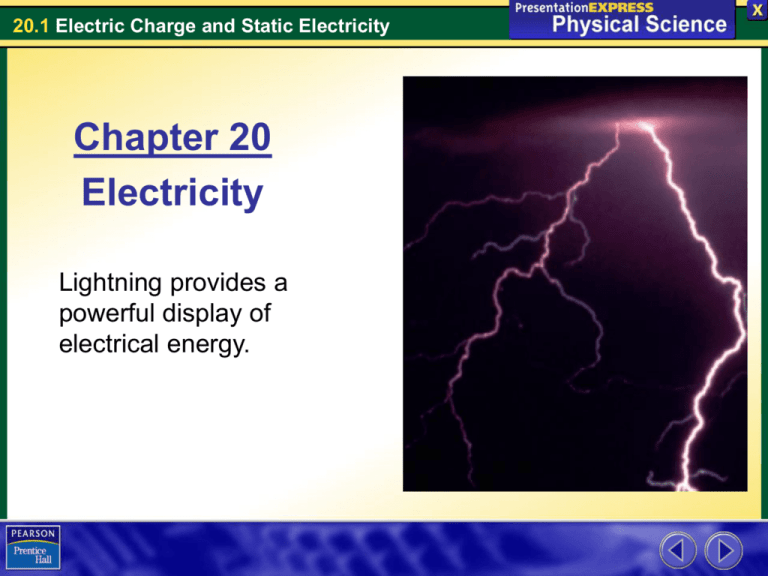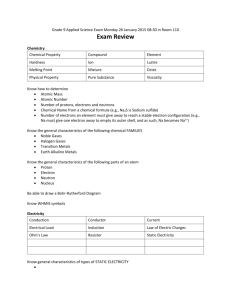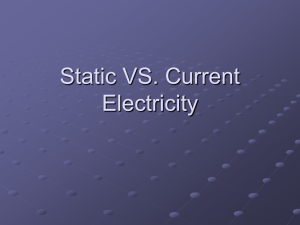20.1 Electric Charge and Static Electricity
advertisement

20.1 Electric Charge and Static Electricity Chapter 20 Electricity Lightning provides a powerful display of electrical energy. 20.1 Electric Charge and Static Electricity 20.1 Key Concepts • What produces a net electric charge? • What determines whether an electric force is attractive or repulsive? • What determines the strength of an electric field? • What are three ways in which charge is transferred? • How does a static discharge occur? 20.1 Electric Charge and Static Electricity When you take clothes out of a dryer, some of them can ____________ together. stick If you pull the clothes apart in a darkened room, you can see ___________ that are like tiny sparks bolts of lightning Lightning and “static cling” have similar causes – the movement of _________________ electric charges 20.1 Electric Charge and Static Electricity Electric Charge Recall that electric charge is a property that attract causes subatomic particles to ____________ or _____________ one another. repel negative Electrons have _________ charges and protons have ____________ charges positive 20.1 Electric Charge and Static Electricity Electric Charge How many protons does this atom have? 8 And electrons? 8 neutral This atom is ___________ equal because it has an ________ number of positive and negative charges 20.1 Electric Charge and Static Electricity Electric Charge • If an atom gains electrons (e-), it becomes a ______________ charged ion. negatively • If an atom loses electrons (e-), it becomes positively a ______________ charged ion. • An excess or shortage of electrons produces a _______ electric charge. net 20.1 Electric Charge and Static Electricity Electric Charge coulomb (C). The SI unit of electric charge is the __________ 6.24 x 1018 • It takes about __________________ electrons to produce a single coulomb. 10 to 20 coulombs of • A lightning bolt is about ____________ 0.025 coulombs. charge, and a camera flash is about _______ 20.1 Electric Charge and Static Electricity Electric Forces Recall that like charges ____________, and repel attract opposite charges _____________. The force of attraction or repulsion between electrically charged objects is _____________ electric ___________. force 20.1 Electric Charge and Static Electricity Electric Forces Doubling the net charge on one object doubles ____________ the electric force. Electric force and net charge have a _____________ directly proportional relationship 20.1 Electric Charge and Static Electricity Electric Forces Doubling the ____________ between the distance reduces objects _______________ the electric force to one fourth the original force. Electric force and distance have an inversely _____________ proportional relationship 20.1 Electric Charge and Static Electricity Electric Forces Inside an atom, electric forces are much stronger ________________ than gravitational forces. • form chemical bonds Electric forces also cause _______________ and friction other contact forces 20.1 Electric Charge and Static Electricity Electric Fields The effect an electric charge has on other charges in the space around it is the charge’s electric _________________. field • . Field of a positive charge Field of a negative charge 20.1 Electric Charge and Static Electricity Electric Fields The strength of an electric field depends on… amount • the ______________ of charge that produces the field distance • and on the ______________ from the charge. 20.1 Electric Charge and Static Electricity Static Electricity and Charging Static electricity is the study of the _________________ of electric charges. behavior Charge can be transferred by… friction __________________ contact __________________ __________________ induction 20.1 Electric Charge and Static Electricity Static Electricity and Charging When studying charge transfers, keep in mind the law of conservation of charge… • states that the total charge in an isolated constant system is _______________. • when there is a charge transfer, the total same charge is the ____________ before and after the transfer occurs. 20.1 Electric Charge and Static Electricity Charging by Friction Rubbing a balloon on your hair causes charging by friction. hair • Electrons move from your ____________ to the balloon _________________ because atoms in rubber have a greater attraction for electrons than atoms in hair. • The balloon picks up a net negative _____________ charge. • Your hair loses electrons and positively becomes ________________ charged. 20.1 Electric Charge and Static Electricity Static Electricity and Charging Charging by Contact A ________________ generator builds a charge on a Van de Graaff metal sphere. Touching the sphere transfers charge by contact. The sphere is still charged, but its net charge is ____________________ reduced 20.1 Electric Charge and Static Electricity Charging by Induction Walking on a carpet builds a ________________ charge on negative your body. The negative charge in your hand repels electrons in a metal doorknob Describe the movement of the electrons in the doorknob as the hand approaches. They move away from the hand 20.1 Electric Charge and Static Electricity Charging by Induction The doorknob is still _____________, but charge neutral has moved ______________ it. within This is induction, a transfer of charge _____________ without contact between materials. 20.1 Electric Charge and Static Electricity Static Discharge Static discharge occurs when a _____________ pathway through which charges can move forms ________________. quickly Why do you get a shock from a doorknob? __________ becomes charged when Air the gap between your finger and the doorknob is _________. small This air provides a path for _______________ to flow. electrons If the room is dark, you can even see the spark. 20.1 Electric Charge and Static Electricity Lightning is a more ______________ discharge. dramatic • Charge can build up in a storm cloud from _________________ between friction moving air masses. • Negative charge in the lower part of the cloud induces a positive charge in the _____________ below. ground air • Eventually the ________ between becomes charged, forming a _________________ for electrons pathway to travel from the cloud to the ground. 20.1 Electric Charge and Static Electricity Assessment Questions 1. Which of the following would double the electric force between two charged objects? a. b. c. d. doubling the mass of the objects cutting the net charge of both objects in half doubling the net charge of one of the objects cutting the distance between the objects in half 20.1 Electric Charge and Static Electricity Assessment Questions 2. The attractive or repulsive effect an electric charge has on other charges in the space around it is the charge’s a. b. c. d. electric force. electric field. static electricity. static discharge. 20.1 Electric Charge and Static Electricity Assessment Questions 3. An object becomes charged by induction when there is a a. b. c. d. transfer of electrons, as the object rubs against another object. transfer of charge, as it contacts another charged object. transfer of charge by motion of electrons within the object. a sudden movement of electric charge from another object.









